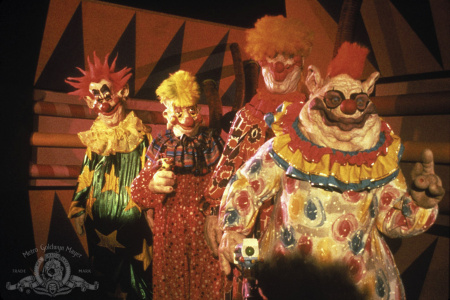The origin story of the 1988 cult classic, 'Killer Klowns from Outer Space'
Série arquivada ("Feed inativo " status)
When?
This feed was archived on October 09, 2021 14:08 (
Why? Feed inativo status. Nossos servidores foram incapazes de recuperar um feed de podcast válido por um período razoável.
What now? You might be able to find a more up-to-date version using the search function. This series will no longer be checked for updates. If you believe this to be in error, please check if the publisher's feed link below is valid and contact support to request the feed be restored or if you have any other concerns about this.
Manage episode 206585069 series 78306

Still from the 1988 film "Killer Klowns from Outer Space."; Credit: The Chiodo Bros
Michelle Lanz | The FrameIt was the late 1980s. Three brothers – Edward, Stephen and Charles Chiodo – were working as special effects animators in L.A. when they decided to make their own low-budget film.
The result was their first feature, "Killer Klowns from Outer Space," released in 1988. It’s a schlocky, sci-fi horror comedy about a gang of murderous clown-like aliens who take over a small town. The Klowns terrorize its inhabitants, trapping them in cotton candy cocoons and smothering them with pies.
It didn’t have much box office success, but in the 30 years since, it has become a cult classic.
To celebrate its 30th anniversary, the Chiodo brothers, along with composer John Massari, are hosting a screening at the Montalban Theater in Hollywood on May 19, complete with a live orchestra and circus performers.
The Frame's Michelle Lanz caught up with them recently to find out the Killer Klown's origin story.
Interview Highlights:
John Massari on why he wanted to be involved in the film:
My involvement in the movie itself is defined by one word, and that's love. Isn't that funny? With "Killer Klowns From Outer Space," love is a thing! The movie is born from imagination and creativity and originality. That's what drew me to it. At the time Tim Burton had just – and by the way the Chiodo brothers have worked for Tim Burton often –he had done "Beetlejuice." I thought, OK, this is the new wave of horror! Comedy, bizarre, creative. I have to do this.
On the birth of the idea:
Stephen Chiodo: I was trying to think of the most frightening image I could imagine. And for me it was traveling down a lonely mountain road and behind me a car would appear. And as it's passing me, it would be a clown staring at me. And that's as silly as the inception of "Killer Klowns" was.
Edward Chiodo: Once you come up with that "Killer Klowns from Outer Space," it kind of writes itself from there. You start thinking about all the circus motifs and opportunities to kill people in humorous, deadly ways.
SC: It really was just a fun process to brainstorm between horror kills and circus motif.
On visualizing the Killer Klowns:
EC: The task was to make something that didn't look like a man in costume or a man in makeup. It had to be a monster from outer space. Something not human, something alien.
SC: This is an alien race that just happens to look like clowns. They weren't supposed to be aliens that would dress up like clowns, they were sort of like a species of slugs from another planet. And their ornamentation just makes them look like clowns. The main thing was that we wanted to avoid anything that a regular clown maniac would do. Our inspiration came from Wes Craven and "Nightmare on Elm Street." And even though it was pretty violent and stuff, what we liked was the aspect of dream kills, where it could be anything in your imagination in the dream world that could kill you. That's what we modeled our killer klown kills after.
On setting the precedent for scary clowns:
EC: It's funny that the image of clowns prior to our movie was pretty normal. Stephen King's "It" [with] Pennywise had come out before the movie, but the miniseries came out after our movie. We were really the first movie to give clowns literal teeth. Our movie didn't really do well and wasn't well-received at the time, but in the last 30 years it's built up this incredible following. It's really become a cult classic.
This content is from Southern California Public Radio. View the original story at SCPR.org.
35 episódios




